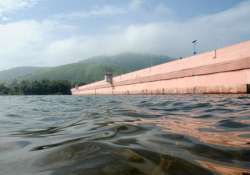New Delhi, May 4: The Supreme Court-appointed Empowered Committee on the Mullaperiyar Dam, over which Tamil Nadu and Kerala are at loggerheads, has concluded that the 119-year-old structure is “safe” and asked the Kerala Government to reconsider its proposal to build a new dam.
The five-member committee headed by former Chief Justice of India Justice A S Anand also recommended that the water level at the dam, located in Kerala's Idduki district and maintained by Tamil Nadu Public Works Department, can now be raised to 142 ft from the existing 136 ft.
In the report, the committee, which made numerous visits to the site and conducted a slew of tests and surveys, has concluded that the Mullaperiyar Dam structure is safe on each of the “hydrologic, structural and seismic considerations”, sources told PTI.
“The Empowered Committee has concluded that the existing Mullaperiyar Dam is safe on each of the hydrologic, structural and seismic considerations. The Empowered Committee, therefore, concludes that the reservoir FRL (Full Reservoir Level) lowered in 1979 to 136 ft can be restored to FRL 142 ft,” the sources said, quoting the report.
The committee, that has one each former Supreme Court judges hailing from Tamil Nadu and Kerala, said “in view of the present safety analysis, Empowered Committee concludes that the proposal of the State of Kerala to build a new dam be reconsidered”, the sources said.
While Tamil Nadu has been maintaining that the dam was “absolutely safe” and the water level can be raised to 142 ft, Kerala has been vociferous in its demand for a new dam to be built near the existing structure.
The Committee also said that the quakes which occured near the dam were “small in magnitude, short-lived and sporadic in nature,” they quoted the report as saying.
The Committee concluded that both the main and the Baby dam were safe and that the water level can be restored to pre-1979 level of 142 ft.
The panel said the dam would remain safe but cannot rule out that despite upkeep the structure may suffer distress due to “reasons beyond anybody's control.” The report said in such an eventuality, the dam may need restoration and strengthening measures which may take years for implementation. “It also might need temporary evacuation of the reservoir level to facilitate implementation of restoration,” the report said.
The Empowered Committee has suggested two alternatives to the Supreme Court as “way forward-towards an amicable resolution” of the issue.
In the first alternative, it said that the Kerala Government may construct a new dam at its own expense to serve its “own perceptions” if it is cleared by Planning Commission and the Environment Ministry.
In that case the existing dam shall not be dismantled, demolished or decommissioned till the new dam construction is completed and becomes operational.
“Till such time, the rights of Tamil Nadu in the existing dam to all waters of Mulla Periyar Dam arising out of the lease deed of 1886 and the agreements of 1970 shall be fully honoured,” the Committee said.
The second alternative suggested by the panel says that during future repairs of the dam to allay fears of people of Kerala of possible damage of land, forest and possible endangering of life, a tunnel can be constructed at a height of 50 feet from the bottom of the dam.
In his note, Justice K T Thomas, who represented Kerala, placed his dissent on record saying the water level should not be allowed to be raised to 142 feet.
“A large number of people living in the neighbourhood areas of the dam are being mentally tormented under stress and agony as they genuinely feel that raising FRL beyond 136 ft may result in destruction of the dam,” he wrote.
He also said raising the water level beyond 136 ft was against a Statue passed by a competent State Legislature. The Kerala Assembly has passed a law that disallows raising the dam level.
In his comment, Justice A R Lakshmanan expressed happiness over the findings of the committee.
Latest India News
